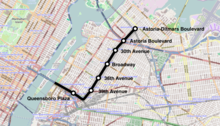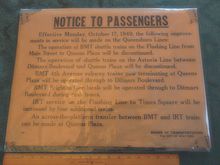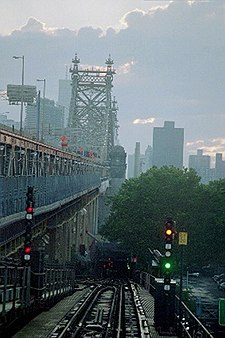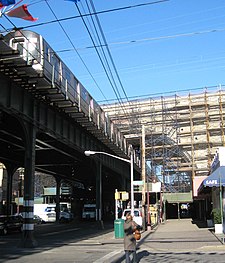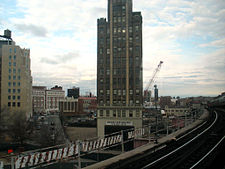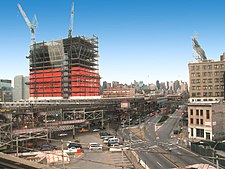
The 7 Flushing Local and <7> Flushing Express are two rapid transit services in the A Division of the New York City Subway, providing local and express services along the full length of the IRT Flushing Line. Their route emblems, or "bullets", are coloured purple, since they serve the Flushing Line.
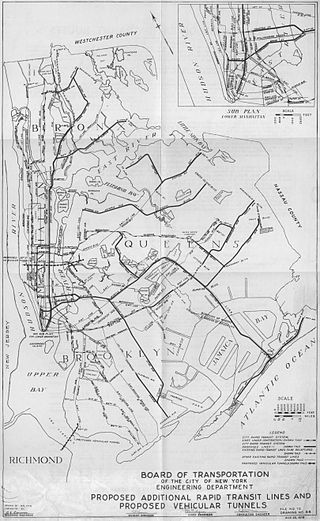
Since the opening of the original New York City Subway line in 1904, and throughout the subway's history, various official and planning agencies have proposed numerous extensions to the subway system. The first major expansion of the subway system was the Dual Contracts, a set of agreements between the City of New York and the IRT and the BRT. The system was expanded into the outer reaches of the Bronx, Brooklyn, and Queens, and it provided for the construction of important lines in Manhattan. This one expansion of the system provided for a majority of today's system.

The Flushing–Main Street station is the eastern terminal on the IRT Flushing Line of the New York City Subway, located at Main Street and Roosevelt Avenue in Downtown Flushing, Queens. It is served by the 7 local train at all times and the <7> express train during rush hours in the peak direction.

The Mets–Willets Point station is a rapid transit station on the IRT Flushing Line of the New York City Subway. Located near the Citi Field baseball stadium, it is served by the 7 train at all times and by the express <7> train rush hours in the peak direction or after sporting events. This station is located near Flushing Meadows–Corona Park in Willets Point, Queens, on Roosevelt Avenue between 114th and 126th Streets.

The 103rd Street–Corona Plaza station is a local station on the IRT Flushing Line of the New York City Subway, located at the intersection of 103rd Street and Roosevelt Avenue. It is served by the 7 train at all times.

The Junction Boulevard station is an express station on the IRT Flushing Line of the New York City Subway, located at the intersection of Junction Boulevard and Roosevelt Avenue in Corona, Queens. It is served by the 7 train at all times and by rush hour peak-direction <7> express service.

The Queensboro Plaza station is an elevated New York City Subway station at Queens Plaza in the Long Island City neighborhood of Queens. It is near the east end of the Queensboro Bridge, with Queens Boulevard running east from the plaza. The station is served by the 7 and N trains at all times, the W train on weekdays, and the <7> train rush hours in the peak direction.

The 52nd Street station is a local station on the IRT Flushing Line of the New York City Subway. Located at the intersection of 52nd Street and Roosevelt Avenue in Woodside, Queens, it is served by the 7 train at all times.

The 46th Street–Bliss Street station is a local station on the IRT Flushing Line of the New York City Subway. Located at the intersection of 46th Street and Queens Boulevard in Sunnyside, Queens, it is served by the 7 train at all times.

The 40th Street–Lowery Street station is a local station on the IRT Flushing Line of the New York City Subway. It is served by the 7 local train at all times.
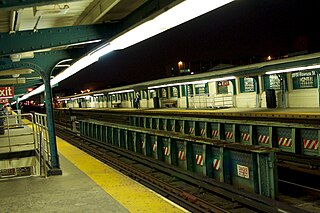
The 33rd Street–Rawson Street station is a local station on the IRT Flushing Line of the New York City Subway. It is located over Queens Boulevard on a concrete viaduct. It is served by the 7 train at all times.
The IRT Flushing Line is a rapid transit route of the New York City Subway system, named for its eastern terminal in Flushing, Queens. It is operated as part of the A Division. The Interborough Rapid Transit Company (IRT), a private operator, had constructed the section of the line from Flushing, Queens, to Times Square, Manhattan between 1915 and 1928. A western extension was opened to Hudson Yards in western Manhattan in 2015, and the line now stretches from Flushing to Chelsea, Manhattan. It carries trains of the 7 local service, as well as the express <7> during rush hours in the peak direction. It is the only currently operational IRT line to serve Queens.
8 was a designation given to two New York City Subway services. It was first used by the Brooklyn–Manhattan Transit Corporation for its Astoria Line from 1917 to 1949. The ex-Interborough Rapid Transit Company (IRT) Third Avenue El subsequently used the designation between 1967 and 1973.

The Astoria–Ditmars Boulevard station, is the northern terminal station on the BMT Astoria Line of the New York City Subway. Located above 31st Street between 23rd Avenue and Ditmars Boulevard in Astoria, Queens, it is served by the N train at all times and the W train on weekdays.

The Astoria Boulevard station is an express station on the BMT Astoria Line of the New York City Subway. Located on 31st Street between Astoria Boulevard and the Grand Central Parkway in Astoria, Queens, the station is served by the N train at all times, as well as by the W train on weekdays.

The 30th Avenue station is a local station on the BMT Astoria Line of the New York City Subway. It is located at 30th Avenue and 31st Street in Astoria. The station is served by the N train at all times, as well as by the W train on weekdays.

The Broadway station is a local station on the BMT Astoria Line of the New York City Subway. It is located above 31st Street at Broadway in Astoria, Queens. The station is served by the N train at all times, as well as by the W train on weekdays.

The 36th Avenue station is a local station on the BMT Astoria Line of the New York City Subway. It is located at the intersection of 36th Avenue and 31st Street in Astoria, Queens. The station is served by the N train at all times, as well as by the W train on weekdays.

The 39th Avenue station is a local station on the BMT Astoria Line of the New York City Subway. It is located at 39th Avenue and 31st Street in Long Island City, Queens. The station is served by the N train at all times, as well as by the W train on weekdays.


